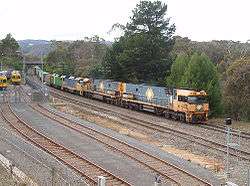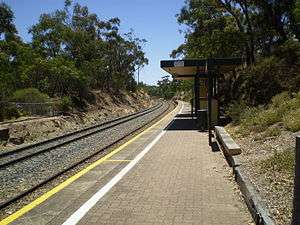Belair railway line
Coordinates: 34°59′33″S 138°37′56″E / 34.992597°S 138.632355°E
| Belair railway line | |
|---|---|
 | |
| Overview | |
| Locale | Adelaide, South Australia |
| Termini |
Adelaide Belair |
| Stations | |
| Services |
|
| Operation | |
| Opened | 1883 |
| Rolling stock | |
| Events | |
| Re-sleepered (concrete) | April–August 2009 |
| Technical | |
| Line length | 21.5 km (13.4 mi) |
| Number of tracks |
Quadruple track to Goodwood Single track to Belair |
| Track gauge | 1,600 mm (5 ft 3 in) |
The Belair railway line is a suburban rail commuter route in the city of Adelaide, South Australia, that runs from the Adelaide station to Belair in the Adelaide Hills via the Adelaide-Wolseley line.
History
The Adelaide-Wolseley from Adelaide to Belair and Bridgewater opened in 1883.
In 1919, a new alignment was built around Sleeps Hill as part of the duplication of the line. This involved a new double track tunnel being built to replace two tunnels and two viaducts.[1] The new alignment was also 400 metres shorter. On 18 June 1928, the line was duplicated from Eden Hills to Blackwood and on to Belair on 24 June 1928.[2]
Passenger services were curtailed beyond Belair on 23 September 1987.[2]
In 1995, the track used by Adelaide bound services was converted to standard gauge as part of the Adelaide to Melbourne standardisation project. The broad gauge passenger services were thus restricted to one track with crossing loops located at Mitcham, Blackwood, Eden Hills and Sleeps Hill. At the same time, the stations at Millswood, Hawthorn and Clapham were closed to speed up services. Millswood reopened on 12 October 2014.[3]
Services
All services are operated by Adelaide Metro's 3000 class railcars. Until June 2007, some services on weekends were operated by a 2000 class railcar modified to incorporate increased bike capacity. In 2005, trains ran the route every 30 minutes on weekdays (hourly after 7pm) and every 60 minutes on weekends and public holidays. From 2006, because of the single line, this was downgraded to every 36/24 minutes on weekdays.
The standard gauge track is used by Great Southern Rail's twice-weekly Overland service to Melbourne and freight trains operated by Aurizon, Genesee & Wyoming Australia, Pacific National and SCT Logistics.
Resleepering
In 2008, the State Government announced a plan to rebuild the Belair line.[4]
This work saw the track removed, with the track bed and track renewed. Dual gauge sleepers were laid to allow for the line to be converted to standard gauge at a future date. Unlike other lines is not planned in the immediate future due to extra engineering work and complications with the standard gauge line. The line closed on 26 April 2009 and reopened on 23 August 2009 with buses replacing trains.[5]
2013 Closure
The Belair line was closed from 1 January 2013 to 14 July 2013 to allow for electrification of the line from Adelaide to Goodwood and construction of a grade separation at Goodwood Junction with relatively work performed on the Belair line itself.[6][7]
Gallery
-

Blackwood station; bus Interchange can be seen on the left
-

Belair station, services to Bridgewater once departed from these platforms. (Now the Australian Rail Track Corporation's Melbourne line tracks)
-

Pacific National freight train passing through Belair
^1 West Terrace tram stop will become Royal Adelaide Hospital when Hospital is constructed.
Interchange Key:
| Image | Service | Operator(s) | Where |
|---|---|---|---|
| Suburban Trains Transfers | Adelaide Metro | Adelaide, Goodwood | |
| Lightrail Transfers | Adelaide Metro | Adelaide | |
| Suburban Bus Transfers | Torrens Transit SouthLink |
see Bus Routes | |
| Interstate Trains Transfers | Great Southern | Adelaide Showground | |
| Bus or Rail Interchange | n/a | Adelaide, Goodwood, Blackwood |
References
- ↑ Sleep's Hill Reserve City of Mitcham
- 1 2 Callaghan, WH (1992). The Overland Railway. Sydney: Australian Railway Historical Society. pp. 124, 217, 239. ISBN 0 909650 29 2.
- ↑ Adelaide's Millswood Station reopens after almost 20 years ABC News 13 October 2014
- ↑ 2008/09 State Budget South Australian Department of Treasury & Finance June 2008
- ↑ Belair Line Renewal Adelaide Metro
- ↑ Goodwood Junction upgrade Department of Planning, Transport & Infrastructure
- ↑ Goodwood Junction Rail Grade Separation York Civil


